When Chrysler introduced their new Neon models back in 1995 under the Dodge and Plymouth nameplates, they said they were launching a new generation of “fun-to-drive” entry-level cars that would appeal to a wide range of people. Everything was new about the Neon: a brand new body, a brand new chassis and two new engines, a 2.0L SOHC and a 2.0L DOHC engine.
The Neon has gone through two generations now (1995-2000 and 2001-2004), and has proved to be a popular car with younger buyers. There are more than 1.5 million of these cars on the road today. However, if you are a fan of these little buggers, you may be sad to hear that there is talk that the Dodge Neon sedan platform will be retired in 2006. T2 will keep you up-to-date on what Chrysler has planned for the vehicle down the road.
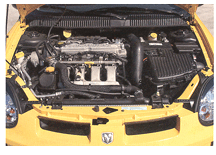 What’s all the Attraction?
What’s all the Attraction?
The low price of older used Neons makes them attractive to teenagers and 20-somethings as daily drivers. But many of these older Neons are also being transformed into street performance cars with all kinds of aftermarket bolt-on goodies including coil-over-suspension kits, wings, spoilers, 19″ wheels and ultra-low-profile street performance tires, performance exhaust systems, low restriction intake systems and other parts. This is good news for our readers because it creates additional service opportunities beyond basic repairs and maintenance.
Even Chrysler has recognized the “tuner” potential of the Neon and introduced a turbocharged high-performance version of the car called the SRT-4 in 2003. The SRT-4 uses a larger 2.4L 16-valve DOHC engine like that in the PT Cruiser, which is conservatively rated at 215 horsepower and 245 ft.-lbs. of torque (some say it’s more like 245 hp at the front wheels!). This much power can punch the SRT-4 from zero to 60 mph in 5.3 seconds and allows it to achieve a top speed of 153 mph – which is fast enough to keep it in the company of other hot sport compacts such as Mitsubishi’s turbocharged Lancer Evolution, the Subaru WRX and the Nissan 350Z.
Service Issues
Time will tell how the latest generation of Neons hold up, but one problem that has plagued the first generation Neons is head gasket failures. Many owners of 1995-’98 Neons have experienced head gasket failures at low miles, typically around 40,000 to 60,000 miles. The first generation OEM head gasket was a conventional design that unfortunately did not prove to be robust enough for the engine. In September 1998, a redesigned multi-layer steel (MLS) head gasket was introduced for the SOHC 2.0L engine and then the DOHC 2.0L.
Chrysler issued a Technical Service Bulletin (TSB 09-05-98) that described the new MLS head gasket and installation procedures. The same gasket also was released to replace the OEM gasket on older Neons, as well as 1995-’99 Avenger/Sebring/Talon models and 1995-2000 Cirrus/Stratus/ Breeze models. A later bulletin (TSB 09-08-99) superseded the previous bulletin and described the installation procedure for the new head gasket.
Aftermarket gasket manufacturers also responded to the Neon problem by introducing redesigned gaskets of their own for these applications. MLS technology proved to be the answer for sealing the Neon. One difference between some of the aftermarket MLS head gaskets and the OEM MLS gasket is that some of the aftermarket gaskets have a thicker surface coating that can seal a rougher surface (60 to 70 microinches). The OEM head gasket version requires a much smoother surface finish (30 to 40 microinches) to seal properly.
A Neon that has a bad head gasket may be leaking oil externally, losing coolant internally (which may result in overheating), and/or losing compression in one or two adjacent cylinders. A compression check or leak-down test can be used to verify a compression leak in the cylinders. Pressure testing the cooling system should reveal any internal coolant leaks via the head gasket. Also, check the dipstick to see if there’s coolant mixed with the oil.
If the head gasket has failed, it must be replaced to prevent further damage from occurring. Coolant in the crankcase can ruin the bearings and rings, so don’t forget to change the oil and filter when replacing the head gasket. Use the better MLS gasket as the replacement. A conventional gasket is cheaper, but probably won’t hold up much better than the OEM gasket. We’ve read numerous reports on the Internet from Neon owners who complain about having had their head gaskets replaced several times. Once should be enough if the job is done correctly and an MLS replacement gasket is used.
If you’re installing an OEM MLS replacement gasket, spray both sides with the recommended sealer before installing it to improve its cold sealability. If you are installing an aftermarket MLS gasket, follow the gasket manufacturer’s instructions – which may not require the use of a sealer because of the thicker coating on the gasket.
Prevent Mistakes
One mistake that’s often made when changing the head gasket on these engines is not checking the flatness of the head and block. Check flatness with a straight edge and feeler gauges. There should be no more than 0.002″ (0.05 mm) out-of-flat in any direction on the head or block surfaces. If the head and/or block are out of flat, one or both should be resurfaced to reduce the warpage. The head can’t handle much milling because taking too much metal off the surface raises the compression ratio and alters OHC cam timing. This, in turn, may increase the risk of detonation and preignition, which will increase the risk of a repeat head gasket failure.
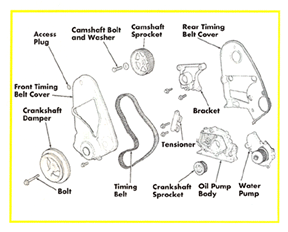 Also, pay close attention to the condition of the head itself. If the coolant passages are badly corroded or eroded, the head may have to be replaced, otherwise it may not seal properly against the head gasket. Also, check the combustion chambers and surfaces for cracks. A visual inspection alone is not good enough here. Use penetrating dye designed for aluminum castings. Many engine rebuilders who do these engines also pressure test the head to check for internal cracks and porosity leaks that might not show up with dye alone.
Also, pay close attention to the condition of the head itself. If the coolant passages are badly corroded or eroded, the head may have to be replaced, otherwise it may not seal properly against the head gasket. Also, check the combustion chambers and surfaces for cracks. A visual inspection alone is not good enough here. Use penetrating dye designed for aluminum castings. Many engine rebuilders who do these engines also pressure test the head to check for internal cracks and porosity leaks that might not show up with dye alone.
Before the head is reinstalled on the engine, make sure the head and block surfaces are clean and that all traces of the original gasket have been removed. Use a chemical gasket remover and flat scraper to clean the surfaces as needed. Although Chrysler says it’s okay to use an abrasive disk to lightly buff off old gasket residue, most engine builders do not recommend this practice because it can also remove metal and create dips in the surface that can prevent the new head gasket from sealing.
Clean and inspect all the head bolt threads in the block. This engine uses torque-to-yield head bolts. Most experts recommend replacing the head bolts with new ones because the old ones stretch when they are tightened down, which increases the risk of breakage if they are reused. Lightly oil the threads on all the head bolts before they are installed. The four short head bolts go in the corners.
Problem Leaks
Another problem that plagues some Neon engines is oil leaks around the cam position sensor. The sensor is located under the intake plumbing from the air cleaner box to the throttle body. TSB 09-07-98 addresses this issue, and recommends replacing the O-ring seal at the sensor. Don’t confuse an oil leak here with a failing head gasket.
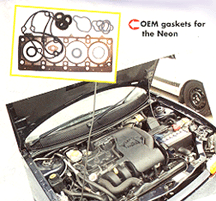 The oil pressure sender also tends to leak oil on some of these engines. The cure here is to remove the sender and use some thread sealer or Teflon tape to seal the threads. Be careful not to get any sealer or tape in the sender hole.
The oil pressure sender also tends to leak oil on some of these engines. The cure here is to remove the sender and use some thread sealer or Teflon tape to seal the threads. Be careful not to get any sealer or tape in the sender hole.
Engine Specs
The 2.0L Neon engine has a cast iron block and aluminum cylinder head. The piston bores measure 87.5 mm and the stroke of the crankshaft is 83.0 mm. The block is a thinwall casting, which means there isn’t enough metal to allow overboring if the cylinders are worn. Chrysler built these motors to be “throw-away” blocks.
There have been several variations in the 2.0L block and heads since the Neon’s introduction in 1995. The 1995 SOHC version of the 2.0L engine had two extra holes cast into the front of the block to accommodate vent tubes for the aspirator system. These blocks also had an oil baffle inside the crankcase to keep oil away from the vent holes. Another difference in the early blocks is the notches for the crankshaft bearing tangs. They are offset from each other unlike later blocks where the tangs are across from each other – which means if you are replacing a set of bearings, you have to grind new tangs for it to accept replacement bearings.
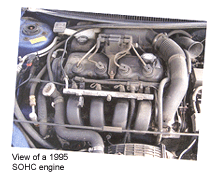 The three center main bearing caps in the block are part of a girdle, or one-piece “bedplate,” that bolts to the bottom of the block. The plate is sealed to the block with an anaerobic sealant, which must be scraped off and resealed if this plate has to be removed to change the bearings.
The three center main bearing caps in the block are part of a girdle, or one-piece “bedplate,” that bolts to the bottom of the block. The plate is sealed to the block with an anaerobic sealant, which must be scraped off and resealed if this plate has to be removed to change the bearings.
The SOHC cylinder heads on the 1995-’99 engines are physically interchangeable, but there are some differences. One is that the 1995 heads have larger 8.0 mm bolts for the rocker covers. The later heads have 6.0 mm bolts for the rocker covers. Also, only the 1995 heads have holes to accommodate the vent tubes. Therefore, if you are replacing a head on 1995 engine, you’ll have to find a ’95 head.
The DOHC heads have larger valves than the SOHC heads (34.5 mm intakes and 29.5 mm exhausts in the DOHC versus 33.0 mm intakes and 28.0 mm exhausts in the SOHC), which allows the DOHC engine to make more power (153 hp) than the SOHC version (132 hp).
The 1995 SOHC engines actually had a somewhat hotter camshaft than the later models. Intake valve lift on the ’95 stock camshaft is 7.8 mm versus 7.2 mm for the 1996-’99 cams. The earlier camshaft is now sold through Mopar as a performance upgrade for the later engines (keep that in mind if you have to replace a cam).
Belt & Pump
The Neon 2.0L SOHC uses a rubber timing belt to drive the cam. The DOHC version of the 2.0L also uses a rubber timing belt to drive its twin cams. Both applications are “interference engines,” which means there’s not enough clearance between the valves and pistons if the timing belt breaks. The recommended replacement interval is 60,000 miles on 1995-’99 models, and 100,000 miles on 2000 and up models.
The flat rate for changing a timing belt on a SOHC 2.0L engine is 2.4 hours versus 3.6 hours for the DOHC version. To change the belt, you have to remove the right engine mount and timing belt cover. A spring-loaded tensioner is used in both engines to maintain tension on the belt, so once you’ve removed it you have to compress it in a vice and temporarily lock it in the compressed position with a 5/16 allen wrench or pin inserted through the body.
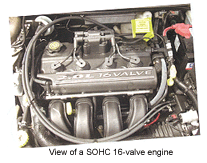 The timing marks on the SOHC engine belt pulleys are both in the straight up position when the crankshaft is rotated to Top Dead Center (TDC). On the DOHC version, the cam sprocket timing marks face each other when the crank is lined up to TDC.
The timing marks on the SOHC engine belt pulleys are both in the straight up position when the crankshaft is rotated to Top Dead Center (TDC). On the DOHC version, the cam sprocket timing marks face each other when the crank is lined up to TDC.
The water pump on the Neon 2.0L engine is located under the timing cover behind the timing belt. If you’re changing the belt, it’s probably a good idea to change the pump also – even if it isn’t leaking yet. The lifespan of the water pump is about the same as the belt, so do the labor once and save your customer the cost of a second repair.
Fire it Up
The 1995 models were equipped with Chrysler’s SBEC II engine control system, while 1996 and later models have the SBEC III computer. All engines have a distributorless ignition system so there’s no cap or rotor to worry about or maintain. The plugs are 100,000-mile platinum tipped. Plug gap is 0.035″. If it is time to change the plugs, check the wires, too. If resistance exceeds specifications, install new wires.
Note: The plugs are in deep wells in the rocker cover. If you find oil in the wells, it means the O-ring seal in the cover needs to be replaced.
The engine is equipped with a rev limiter to prevent over-revving the engine when accelerating. The rev limiter kicks in at 6,750 rpm on the SOHC and DOHC engines, but DOHC engines with automatic transmissions can go to 7,250 rpm. On cars with manual transmissions, the rev limiter is no help if the driver downshifts to too low a gear at a high speed. My nephew did this to his Neon and destroyed several valves!


